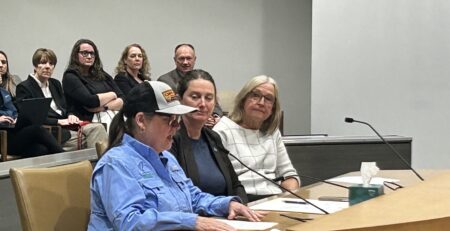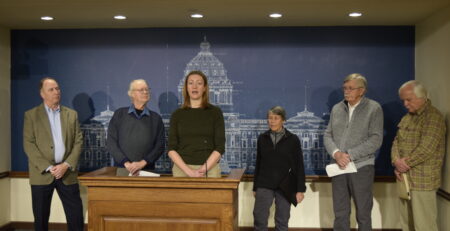MN Legislature is about to take away the state’s authority to protect groundwater and drinking water.
On Monday afternoon April 16, both the Minnesota House and Senate will debate bills that limit the state’s ability to protect our groundwater, which is both our drinking water and the lifeblood of trout streams.
Existing Minnesota law gives the state authority to protect groundwater and drinking water. It is called the Groundwater Protection Act and it was passed in 1989 with broad support from both political parties. Contamination from rising nitrate levels is impacting thousands of people and dozens of communities across the state. It is also negatively impacting trout fisheries.
Because this is also a growing public health issue, the Minnesota Department of Agriculture (MDA) is proposing a Groundwater Protection Rule that will help communities address rising nitrate levels. Yet, amazingly, the legislature is poised to pass legislation that effectively blocks this very modest rule and the ability of state agencies to protect citizens, their drinking water, and trout fisheries from nitrate pollution.
Please call or e mail your state legislators today:
Ask your House member to vote “no” of HF 2887
The House bill – HF 2887 – will be heard on the House floor Monday afternoon. The bill undermines the MDA’s ability to protect groundwater by putting unnecessary delays and legislative hurdles into an already lengthy and comprehensive public process. HF 2887 undercuts the authority and ability of our state agencies to protect our groundwater, public health and trout fisheries. Urge your House member to vote “no” on this bad bill.
Ask your Senator to vote to remove provision blocking adoption of nitrogen rule
An identical provision to the House bill will be slipped into Senate bill SF 2893 (via the DE-2893 amendment) and heard in the Senate Agriculture Finance Committee on Monday afternoon. Urge your Senator to vote “no” on this provision today (if they serve on that Committee) or when it reaches the Senate floor.
How to Reach Your Legislator in 1 Minute:
Legislators listen most to their voters, not organizations. A short call or e mail by you can have a huge impact. Quickly get links to your legislators’ e mail and phone numbers using this legislative link: http://www.gis.leg.mn/iMaps/districts/ Type your address in the box and both your legislators will pop up, with links to their e mail forms. Along with email information, their phone numbers are also provided and simple, short calls are very effective.
Background
About 70% of Minnesotans get their drinking water from groundwater via public and private wells. That is why the legislature approved the bipartisan 1989 Groundwater Protection Act, which gives the state authority to prevent contamination of our groundwater.
Nitrate contamination in groundwater used for drinking water is a growing public health issue. Extensive research shows that nitrate from nitrogen fertilizer can leach below the root zone and migrate into our groundwater. Despite farmers’ widespread adoption of more efficient nitrogen fertilizer application practices, the problem is getting worse:
- 537 public water supply wells across the state have elevated nitrate levels.
- More than 50 communities in MN are facing significantly elevated nitrate levels.
- Nearly 10% of MDA tested private wells in vulnerable areas exceed the Health Risk Limit (HRL), including some townships with 30-40% or more of private wells unsafe to drink.
- 15 trout streams, including 12 in southeast MN are impaired due to high nitrate levels
To address this growing nitrate problem, the Minnesota Department of Agriculture (MDA) updated its Nitrogen Fertilizer Management Plan (NFMP) beginning in 2010, with assistance from stakeholders, advisors and more than 420 written comments from citizens over a five-year process. Based on the revised NFMP, the MDA released an informal draft Groundwater Protection Rule in 2017. The agency hosted 17 statewide listening sessions engaging over 1,500 individuals and reviewed over 820 written comments. Following extensive revisions, the MDA released a revised draft rule in March 2018, to be followed by additional stakeholder input and public participation prior to adoption.
The rule helps protect public health and trout streams while maintaining farm productivity
Part 1 of the rule restricts nitrogen fertilizer application in the fall and on frozen soils on only the most vulnerable soils and wellhead protection areas in Minnesota.
- Part 1 applies to only 12.6% of Minnesota’s farmland; areas where relatively few farm operators practice fall/frozen soil application today.
- Fall/winter application of nitrogen on vulnerable soils is not recommended under University of Minnesota Best Management Practices.
- Fall/frozen soil application in the wellhead areas of communities with already-elevated nitrate levels poses a significant risk to public health.
Part 2 of the rule applies only in community wellhead protection areas (Drinking Water Supply Management Areas (DWSMAS)) – about 0.45% of Minnesota’s cropland. The rule promotes voluntary best management practice adoption, followed by common-sense regulatory requirements developed in consultation with a local advisory team – including area farmers to reduce nitrate levels in these water supplies.
We have waited nearly 30 years for the state to act in the face of mounting evidence of nitrate pollution in our groundwater. The proposed rule is a modest first step to implement the Groundwater Protection Act and protect and protect public health, drinking water and the groundwater which sustains our trout fisheries. The legislature should not undermine this commonsense first step to do just that.


